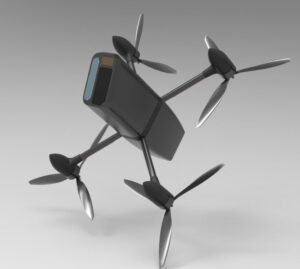
“Science has not yet mastered prophecy,” said legendary astronaut Neil Armstrong. “We predict too much for the next year and yet far too little for the next ten.”
Continue reading below, or listen:
The Drone Industry in the Last Ten Years
It may be hard for newer entrants to the sector to realize that just 10 years ago, the commercial use of drones was actually illegal in the United States, according to a Section 333. From 2014 – 2016, companies who wished to operate drones commercially had to receive a Section 333 exemption from the FAA. It wasn’t until the introduction of Part 107 in 2016 that there was a clear and standardized legal path for commercial drone use.
While Part 107 was a huge step forward for the drone industry, drones were still primarily flying cameras – and obstacle avoidance systems weren’t yet commonplace. Hardware and operating systems have made huge strides over the last 8 years – drones are much easier to fly consistently and safely, and sensors and use cases have continued to evolve.
As the drone industry grew, so did the paperwork for both pilots and FAA. FAA released the first version of the B4UFly app in 2016. The LAANC (Low Altitude Authorization and Notification Capability) was introduced in 2017, further smoothing the way to commercial drone use. Since then, as FAA partner Aloft announced in July of 2022, the B4UFly app has processed more than 20 million airspace searches, and in 2022 commercial LAANC authorizations increased more than 100% over the year before. A rule of operations over people and at night was implemented in 2021, removing further barriers to commercial operation. Remote ID – announced at the very end of 2019 – will be finally implemented in 2023.
Along the way, as the “gray area” of commercial drone operation cleared and enterprises were able to license, insure, and standardize drone operations, use cases evolved. In 2013, most drone used commercially were used to capture pictures of homes, weddings, news stories, or other easily consumable images. In 2022, we’ve seen drones used to create sophisticated 3D models of assets like telecom towers, assist police and swat teams with two way communications, and carry sophisticated sensors to detect minute changes in atmosphere. We’ve progressed from having to watch the drone in front of you while you manipulated joysticks to the possibility of operating a drone on Mars from the safe comfort of an office on Earth.
3 Predictions for the Drone Industry in 2023
As we look back at the amazing changes we’ve seen in the last decade, we’re looking forward with optimism and excitement to next year. Here are our top 3 predictions for the drone industry in 2023.
- Drone Delivery Comes to a Retail Store Near You. It’s taken several years for drone delivery to get real – and legal. Finally, 2022 saw Walmart expand their standard drone delivery program to serve millions of households with drone services partner DroneUp. Flytrex has partnered with fast food outlets in multiple states. Wing and Zipline have moved into the U.S. Matternet received the first ever type certification in 2022. In Europe and Asia, government mail services are utilizing drone delivery. Amazon has at last begun their trials in 2 U.S. states. Still, for most of us, drone delivery is something we just think about while the Amazon, UPS, or DHL truck drives past. That may change this year. With BVLOS flight becoming ever more common – even without a published rule – and type certification moving forward, drone delivery is poised to scale at last.
- Counter Drone Technology Gets Implemented. Counter drone technology is an important partner for the commercial drone industry. Currently, however, laws prohibit the widespread implementation of drone mitigation technology. As cUAS technology continues to advance and more drones, both commercial and recreational, fill the skies we predict that infrastructure and energy companies will lobby to be able to put counter drone systems in place.
- Drones Operated from a Central Command Post Become Standard on Industrial Sites. The BVLOS ARC was formed in June of 2021, and its recommendations released in March of 2022. Sooner or later – and we all hope for the former – the FAA will release a NPRM on drone flight beyond visual line of sight (BVLOS). When that happens, we predict that companies, law enforcement, and government entities will move quickly to implement remote operations for security, monitoring, or maintenance applications using drone in a box solutions operated from a central command post.
Whatever happens in 2023, we’ve learned a lot in the last ten years. The drone industry is living up to its promise to perform dark, dirty and dangerous jobs quickly, safely, and cheaply. Drones are no longer a solution in search of a problem – they’re a significant tool driving efficiency and innovation. In 2013, we may have been a little overly optimistic about the timeline: but we couldn’t possibly have foreseen the amazing developments and achievements we’ve witnessed since then.
The best is surely yet to come.
Read more:
- Top Drone Manufacturers of 2022: Whats Changed?
- Walmart Drone Delivery Now Available from 11 New Stores in Texas
- American Robotics Reese Mozer on the Many Types of BVLOS Flight: EVLOS, True BVLOS, Automated, and More
- The Changing Threat Landscape: How Criminal Use of Drones and Counter Drone Technology is Evolving
Miriam McNabb is the Editor-in-Chief of DRONELIFE and CEO of JobForDrones, a professional drone services marketplace, and a fascinated observer of the emerging drone industry and the regulatory environment for drones. Miriam has penned over 3,000 articles focused on the commercial drone space and is an international speaker and recognized figure in the industry. Miriam has a degree from the University of Chicago and over 20 years of experience in high tech sales and marketing for new technologies.
For drone industry consulting or writing, Email Miriam.
TWITTER:@spaldingbarker
Subscribe to DroneLife here.